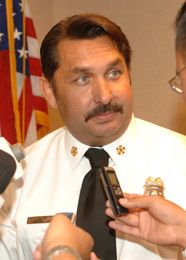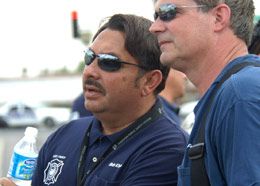By Jamie Thompson
FireRescue1 News Editor
 Photo Phoenix FD |
Becoming fire chief for the first time can be daunting enough — but following in the footsteps of a fire service legend is doubly challenging.
It was the task Bob Khan faced when he succeeded the retiring Alan Brunacini in heading the Phoenix Fire Department in August last year.
Khan looks back on that transitional period candidly. Despite being an internal appointment, he knew he had to be his own man and implement ideas and changes he thought were best for the department.
“It was a very tough time — for both of us,” he said. “I’m not sure either one of us knew how to go through that change.”
What Khan, who was born and raised in Phoenix, did was set about building on Brunacini’s legacy to meet the challenges the fire service faces today.
“I think the fire service generally has traditionally been a very close knit thing, and in some ways is almost like a sovereign nation, a family business,” Khan said.
In the post-9/11 world, he added, things have changed. According to Khan, communities themselves are beginning to take ownership of fire departments, particularly in metropolitan areas.
“They want to know what we are doing, they have safety concerns,” he said. “It’s becoming a complicated business.”
In Phoenix, Khan oversees a department of nearly 2,000 members, 53 fire stations with more on the way, and a $220 million budget.
“There are 1.9 million people (living or working) here that are relying on my group for any fire, medical or nowadays even special hazard emergency 24/7,” Khan said. “That’s a pretty complicated process.”
Public face
Even before becoming chief, Khan had a high profile in the city as the public face of the fire department for the previous decade.
In 1996, he was approached by Brunacini and union officials to head the public information office. Up until then, Khan had been perfectly content as a firefighter in a south central Phoenix paramedic company.
When he agreed to the public information role, Khan believed it would be for a year or so, after which he could return his previous role on the firefighting frontline.
“I didn’t really want to leave Engine 2,” he said. “I didn’t see myself doing staff work as I liked what I was doing. But I ended up enjoying it.”
What followed was a quick ascension through the ranks, as he became a community liaison officer, division chief and then assistant chief in 2001.
While in the different roles, he gravitated toward labor relations and community affairs, something that led to frequent dealings with elected officials.
It all stood him in good stead for his appointment as Phoenix fire chief.
“I think the role of fire chief has changed in a lot ways, especially the big cities,” Khan said. “It’s become administrative as well as operational, and understanding both arenas is helpful.”
Modern chiefs
The modern fire chief has a lot to juggle — labor laws and negotiations, legal issues, increased fire prevention duties, dealing with local government leaders and accountability to the community. But for Khan, the heart of the job still lies in helping the staff at ground level, something he says he is always keen to focus on.
He said that when he began his work in an administrative capacity at Phoenix Fire Department, it was always directed at how it could benefit the men and women in the station, where he had been for 14 years. “In my opinion, that’s what the fire chief has to do,” Khan said.
Now that he’s 16 months into the job, Khan outlines his main responsibilities as chief as five-fold: safety, teamwork and internal relations, customer service, ensuring a good physical environment for firefighters, and personal development.
Khan had both the backing of Brunacini and city managers in becoming the new chief. Internal appointments, Khan said, have both their advantages and drawbacks.
When implementing changes, he said, the key is to be strong enough to be able to make the changes that you believe in.
“If you’ve come in from the outside, that part can be easier,” Khan said. “But by coming from the outside, then you don’t know the system and the process within the department, which can be difficult. Each department does have its own culture.”
Strategic plan
One of Khan’s biggest achievements — a strategic plan that aimed to identify the department’s main challenges and offer solutions — was also one of the first projects as chief that he embarked on.
Khan made sure the whole department — from firefighter to executive chief — was involved in drawing up the document.
He is hopeful the plan can evolve and respond with the times and the challenges that may lie ahead. Already looking ahead to the future, Khan describes it as a “roadmap” for his eventual successor.
 Photo Phoenix FD |
Looking back on his own succession to Brunacini, Khan can now look back and admit there is no easy way to begin such a transition.
“But at the end of the day, he was going to have to find some closure with that retirement and I was going to have to go pick things up and move forward.”
At the heart of his leadership, Khan said, is the duty to his firefighters.
“Everything I do needs to be related to the service they are providing,” he said. “If they are not doing a good job, then it means I’m not.”
Bob Khan profile
Born and raised in Phoenix, Chief Khan joined the Phoenix Fire Department in 1982, after graduating from Arizona State University. He is also a graduate of the John F. Kennedy School of Government’s Crisis Management program, the MIT Negotiating Labor Agreement program, and the Arizona State University Fire Science Institute. He is well recognized for his work in the community for educating the public on life safety issues and also worked with the executive staff at the Phoenix Police Department to develop the joint Homeland Security Bureau.











